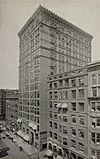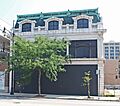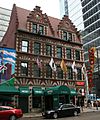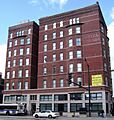National Register of Historic Places listings in Central Chicago facts for kids
Central Chicago is home to many important buildings and places listed on the National Register of Historic Places. This special list includes sites that are historically significant or have unique architecture, meaning they are worth protecting for future generations. In Central Chicago, there are 124 such places, out of 374 across the entire city.
Central Chicago covers three main parts of the city: the Loop, which is the historic business and cultural heart; the Near North Side; and the Near South Side. This area stretches about five and a quarter miles from north to south and about one and a half miles from east to west. It's bordered by Lake Michigan to the east, the Chicago River to the west, North Avenue to the north, and 26th Street to the south.
Many of Chicago's famous early skyscrapers, known for their unique "Chicago School" style of architecture, are found here. These include the Monadnock and Reliance Buildings, designed by Burnham and Root. You'll also find buildings from the early Modernist period, like Ludwig Mies van der Rohe's IBM Building and the 860–880 Lake Shore Drive Apartments.
Chicago's oldest surviving building, the Henry B. Clarke House, is located on the Near South Side. It's close to the Prairie Avenue District, which is famous for its beautiful old homes. The work of well-known architect Louis Sullivan can be seen in buildings like the Carson, Pirie, Scott and Company Building and the Auditorium Building. Even Frank Lloyd Wright, another famous architect, worked on a renovation of the lobby in the Rookery Building early in his career.
This central area also features several important religious buildings, six historic hotels, and four theaters, showing how diverse and rich Chicago's history is.
Contents
Cool Historic Places in Central Chicago
Central Chicago is packed with amazing buildings and sites that tell stories of the past. Here are just a few examples of the many places listed on the National Register of Historic Places:
Skyscrapers and Famous Buildings
Many of Chicago's historic buildings are tall skyscrapers, showing off the city's early leadership in building upward.
- Auditorium Building: This grand building, finished in 1889, is known for its amazing design and was once a huge theater and hotel. Today, it's part of Roosevelt University.
- Carson, Pirie, Scott and Company Building: Designed by Louis Sullivan, this building is famous for its beautiful decorative ironwork at the base, which was very modern for its time.
- Chicago Board of Trade Building: This towering building, completed in 1930, was once the main place where people traded goods like corn and wheat. It's a great example of Art Deco style.
- Monadnock Building: Built in 1891, this is one of the tallest load-bearing masonry buildings ever constructed, meaning its walls support its weight without a steel frame. It's a true architectural marvel.
- Reliance Building: Finished in 1895, this building is famous for its large glass windows and light steel frame, which was a new way to build tall buildings back then.
- Rookery Building: This historic building, completed in 1888, has a stunning central light court. Frank Lloyd Wright even redesigned its lobby in the early 1900s.
- IBM Building: A sleek, modern skyscraper designed by Ludwig Mies van der Rohe, completed in 1971. It shows a different style of architecture compared to the older buildings.
- Inland Steel Building: Another example of modern architecture, this building from 1957 was one of the first skyscrapers to use stainless steel for its exterior.
Museums and Public Spaces
Central Chicago also has important cultural and public spaces that are part of the National Register.
- Adler Planetarium: Opened in 1930, this was the first planetarium in the Western Hemisphere. It's a cool place to learn about space and stars.
- Field Museum of Natural History: A huge museum dedicated to natural history, opened in 1921. It's home to many amazing exhibits, including Sue, one of the most complete T-Rex skeletons.
- Shedd Aquarium: One of the largest indoor aquariums in the world, opened in 1930. It's home to thousands of aquatic animals from all over the globe.
- Grant Park: Often called "Chicago's Front Yard," this large urban park is home to famous landmarks like Buckingham Fountain and hosts many festivals and events.
- Navy Pier: Originally built in 1916 as a shipping and recreation pier, it's now a popular spot with rides, restaurants, and entertainment, offering great views of the city and lake.
Historic Homes and Districts
Some areas and individual homes are preserved for their unique history and design.
- Henry B. Clarke House: Built in 1836, this is the oldest surviving house in Chicago. It gives us a peek into what life was like in the city's early days.
- James Charnley House: Designed by Louis Sullivan and Frank Lloyd Wright in 1892, this house is an important example of early modern American architecture.
- John J. Glessner House: A unique home built in 1887 by architect Henry Hobson Richardson. It's known for its strong, fortress-like appearance and innovative interior design.
- Prairie Avenue District: This historic neighborhood was once home to many of Chicago's wealthiest families. It features beautiful mansions from the late 1800s, including the Glessner House.
- Gold Coast Historic District: A fancy neighborhood known for its historic mansions and elegant apartment buildings, showing off the luxurious lifestyle of Chicago's past.
Other Notable Sites
- Chicago Theatre: This grand movie palace, opened in 1921, is famous for its iconic marquee sign and beautiful interior. It still hosts concerts and shows today.
- Drake Hotel: A luxurious hotel opened in 1920, known for its fancy events and famous guests. It sits at the top of Michigan Avenue.
- Fourth Presbyterian Church of Chicago: A beautiful Gothic-style church built in 1914, located right on Michigan Avenue.
- Jean Baptiste Point Du Sable Homesite: This site marks where Jean Baptiste Point Du Sable, often called the "Founder of Chicago," built his home and trading post in the late 1700s.
Former Historic Listings
Some places that were once on the National Register of Historic Places in Central Chicago are no longer listed. This usually happens if a building is torn down or changed so much that it loses its original historic value. For example, the original Chicago Stock Exchange Building and Grand Central Passenger Station were both removed from the list after they were demolished. Soldier Field was also removed after it underwent major renovations.
| Name on the Register | Image | Date listed | Date removed | Location | Summary | |
|---|---|---|---|---|---|---|
| 1 | Chicago Stock Exchange Building |
(#70000911) |
|
30 N. LaSalle St. |
Demolished in 1972. | |
| 2 | Grand Central Passenger Station |
(#71001084) |
|
S. Wells and Harrison |
Demolished in 1971. | |
| 3 | Leiter I Building |
(#70000910) |
|
200–208 W. Monroe St. |
Demolished in 1972 | |
| 4 | McCarthy Building |
(#76000698) |
|
Washington and Dearborn Sts. |
Demolished | |
| 5 | New Michigan Hotel |
(#83003562) |
|
2135 S. Michigan Avenue |
Originally the Lexington Hotel; the building was demolished in 1996. | |
| 6 | Soldier Field |
(#84001052) |
|
425 E. 14th Street 41°51′45″N 87°36′59″W / 41.8625°N 87.616389°W |
Near South Side. Designation removed due to extensive renovations. | |
| 7 | Unity Building |
(#79000829) |
|
127 N. Dearborn St. |
Demolished in 1989 | |
| 8 | Western Methodist Book Concern Building |
(#75000654) |
|
12 W. Washington St. |
Images for kids |





































































